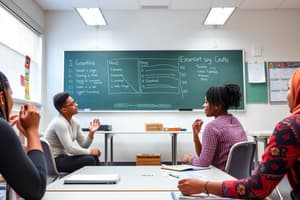Podcast
Questions and Answers
What is the primary focus of culturally responsive teaching, according to Amanda Armstrong?
What is the primary focus of culturally responsive teaching, according to Amanda Armstrong?
- Adapting teaching strategies to align with standardized testing requirements.
- Validating and affirming students' cultures, incorporating them meaningfully into learning and the environment. (correct)
- Focusing on teaching a singular dominant culture to promote unity.
- Strict adherence to traditional teaching methods while acknowledging diverse cultures.
Which of the following strategies best exemplifies culturally responsive teaching in literacy?
Which of the following strategies best exemplifies culturally responsive teaching in literacy?
- Selecting books and software that mirror children's backgrounds, languages, and environments. (correct)
- Using only classic literature to build a foundation in established literary traditions.
- Focusing on English-only materials to improve language proficiency.
- Prioritizing materials that cover a wide range of topics without considering cultural relevance.
How can educators effectively incorporate music to support culturally responsive teaching during classroom transitions?
How can educators effectively incorporate music to support culturally responsive teaching during classroom transitions?
- Playing solely classical music to create a calming atmosphere.
- Avoiding music altogether to reduce distractions.
- Including various genres familiar to children or reflective of their cultural communities. (correct)
- Only playing music in English to improve auditory processing skills.
What is the significance of using everyday objects familiar to students, such as shells or rocks, in mathematical activities?
What is the significance of using everyday objects familiar to students, such as shells or rocks, in mathematical activities?
How does building connections with students and families contribute to culturally responsive teaching?
How does building connections with students and families contribute to culturally responsive teaching?
What is the purpose of an educator being a 'learner' in the context of culturally responsive teaching?
What is the purpose of an educator being a 'learner' in the context of culturally responsive teaching?
Which outcome is most likely to result from effectively implementing culturally responsive teaching?
Which outcome is most likely to result from effectively implementing culturally responsive teaching?
What initial step can a teacher take to understand the cultural backgrounds of their students?
What initial step can a teacher take to understand the cultural backgrounds of their students?
Flashcards
Culturally Responsive Teaching
Culturally Responsive Teaching
An approach that values and affirms students' cultures, integrating them into learning and the environment.
Culturally Responsive Literacy
Culturally Responsive Literacy
Selecting books and software that mirror children’s backgrounds, languages, and routines.
Culturally Responsive Music
Culturally Responsive Music
Using music from various genres that reflect children's cultural communities.
Culturally Relevant Materials
Culturally Relevant Materials
Signup and view all the flashcards
Authentic Learning Situations
Authentic Learning Situations
Signup and view all the flashcards
Building Connections
Building Connections
Signup and view all the flashcards
Family Surveys
Family Surveys
Signup and view all the flashcards
Be a Learner
Be a Learner
Signup and view all the flashcards
Study Notes
- Culturally Responsive Teaching is covered in EDUC 104
Outcomes
- The aim is to define culturally responsive teaching
- Students learn to implement culturally responsive teaching practices
- Participants will be able to describe the benefits and challenges of culturally responsive teaching
Warm Up
- Prompts include if you have traveled outside America
- Have you worked with children/families from other countries
- Do you know cultural practices that are different from American practices
- Do you speak another language
Defining Culturally Responsive Teaching
- Amanda Armstrong defines it as an approach to validate and affirm students' cultures
- It incorporates students' cultures into learning and the environment
- This definition comes from the article “Culturally Responsive Teaching in Early Childhood”
Strategies
- Culturally responsive teaching should apply in all areas of study
- Select reading that represents the students background, language, and environment
- Incorporate books and software that are bilingual to make real world connections
- Other students can learn about different experiences and different perspectives
Encouraging Creativity
- Promote different genres of music that reflect the culture, community, and experiences of students
- Use objects that the children are familiar with (shells, rocks, sticks, etc.)
- Seek input from families for activities
- Include labels in multiple languages
Use Authentic Situations
- Use authentic situations to provide cultural learning
Building Connections with Students and Families
- Getting to know students helps instructors be responsive in a way that authentically represents the learners
- Performing beginning of the year surveys is a good way to do this
- Surveys should ask about language use and home practices
Importance of Being a Learner
- One should review books, podcasts, articles, and research
- The aim is to describe cultural issues and nuances in communities, families, and educational settings
- This will help teachers get different viewpoints and become culturally aware
The Result of Culturally Responsive Teaching
- Students are more engaged, motivated, and connected when teaching is culturally responsive
Closure
- It is appropriate to plan a unit to spend about a week or two learning about different holidays and cultures
Studying That Suits You
Use AI to generate personalized quizzes and flashcards to suit your learning preferences.




